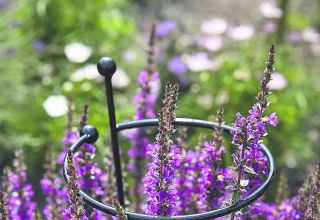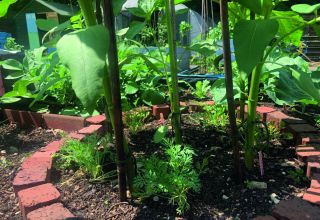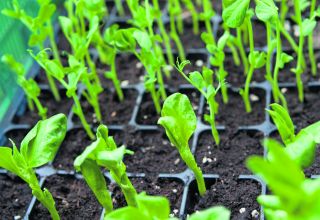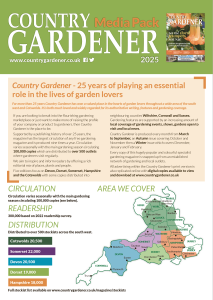The ground is wet with dew in the mornings and the garden is covered in cobwebs, but some days may still be glorious and warm. This may be the first month some areas of the country experience their first frosts. The leaves are falling from the trees in abundance and a lot of summer crops are coming to an end. It can be difficult to know how best to care for your garden.
1. It’s time to assess the state of your soil
Large areas of bare soil start to appear in all parts of the garden as we go through October. If left to over winter, the soil will lose its nutrients, so now is the perfect time to use organic mulches to protect it and give good structure for next year’s growing season. The best mulches are a thick layer of:
- Autumn leaves, wetted so that they don’t blow away.
- Straw, grass clippings and autumn leaves mixed.
- Cutback plants such as sweet peas, peas or runner beans, chopped up.
- Several sheets of newspaper, covered with damp grass clippings to weigh it all down.
Don’t put compost down now, many of its nutrients could be washed away over winter. Use it in spring before the growing season.
2. Get planting those fruit trees
Plant new fruit trees and bushes. Choose ‘bare root’ plants, they usually cost less than pot grown ones. Ideally choose organic stock, certified disease free and from an organic nursery. The soil is still warm now so plants will be able to start developing a good root system before winter.

3. Start a winter compost trench:
A compost trench is an easy and hugely helpful addition to the vegetable plot and will be next season’s planting area for moisture-loving crops such as runner beans or pumpkins.
You dig a trench,or any shape hole,approximately 12 inches deep in an empty space of your garden, add roughly four to six inches of compostable materials, such as kitchen scraps, spent garden plants, small prunings, thinnings, and weeds, and bury them with the soil you dug out of the trench or hole. If you can do it little and often so you build up layers of soil and compostable waste.
Plant roots make their way down deeper into the soil in search of the nutrition you buried there. So, nearby plants are healthier in two ways: they are nourished from the organic matter in the trench, and they benefit from a deep, strong root system. The plants are better able to cope with dry conditions and heat.
4. Remove greenhouse crops
Greenhouse crops, such as tomatoes, are past their best by October, so remove the old plants and put them in the compost bin. If you have any green tomatoes, we found the best method for ripening them is to put them in a dark place with a gentle, room-temperature level of warmth, such as in a kitchen drawer.

5. Save those autumn seeds
Different people save seeds for different reasons. Some do it to preserve a link with the past, growing a variety their parents grew or one peculiar to the place they live. Some do it to assure themselves a supply of seed of a variety no longer available. Some people are saving seed because they always have done so. The easiest plants for seed saving are peas, beans, lettuce, tomatoes, and peppers. Collect ripe seed on a dry day, as soon as the seedheads (e.g., capsules or pods) ripen. This is often indicated by a colour change from green to brown, black or red, but must be before they open and shed their contents.
Pick the seedheads, either singly or on stalks, and lay them out to dry on a greenhouse bench, warm windowsill or in an airing cupboard. This enables seed to be more easily extracted from pods, cones or capsules.
Before you place your seeds in storage, it’s important that they are dry. If seeds are too wet, they can rot and will be no use.
Some seeds ,hellebores for example are best sown immediately as their viability reduces with storage. However, for many species, sowing is best delayed until a more suitable time of the year, such as autumn or spring, so the harvested seed will need to be safely stored until sowing. Storing is also required if surplus seed has been collected.

6. Get garlic in the ground
Garlic is best planted in October. Break the bulb into individual cloves and push into the soil- use a trowel to avoid damaging them -so the tip is just covered. Space the cloves 15cm apart in rows 30cm apart, so it will be easy to hoe off weeds. If you can, grow garlic indoors in a cold greenhouse or polytunnel as outdoor crops have been suffering from rust in recent years and aren’t growing as big as indoor ones. They should be ready to harvest next June.

7. Make your own leaf mould
Collect deciduous autumn leaves and store, to create leaf mould. Make sure leaves are damp and use plastic sacks with holes for air circulation. Trials over many years have shown the value of adding leaf mould to the soil. Plants are healthier, crop yields are higher, and pest/disease problems fewer.
Which? Gardening has trialled different methods of making leaf mould, and this method came out on top: Shred the leaves by running over them with a lawn mower or by collecting them with a leaf blower vacuum. If the leaves aren’t moist already, sprinkle them with water. Put them in black plastic bags and seal when full. Use a garden fork to pierce a few holes in the bags. Leave the bags in a quiet corner of the garden. Light, crumbly leaf mould should be ready in 12 months.
8. October lawn care
Make sure you care for your lawn by raking or brushing leaves off the grass. Try collecting them in a leaf bag, which will turn them into leaf mould – a useful and versatile soil conditioner. You can also cut the grass for the final time of the year at the end of October. Make sure that the last cut is slightly higher than during the summer months – this will help to protect your lawn.

9. TLC for your tools
You might not be seeing much of your tools in the coming months but give them a good cleaning before they bed down for the season. Scrape mud off spades, forks and hoes. If the mud is caked on then dunk them in warm, soapy water and wipe them down with an old towel or cloth. Rub oil (any type will do) onto the metal blades before putting them away for winter and store them in a dry shelter for the rest of winter. This will mean they’ll be rust-free and good-as-new by the time you come to need them again.

10. Tidy up tired looking fruit trees
In October many apple and pear trees will start to look rather dishevelled after the growing season and it’s the perfect time to get rid of old and diseased wood. Prune out canker-infected branches and twigs on apples and pears. Disinfect your tools afterwards. This tidy up will be of huge benefit when the trees look to come to life next season. But don’t prune cherries, plums and peaches and apricots. Wait until the spring when the sap is moving and wounds heal rapidly.
11. Don’t panic is there’s an early frost
Try not to get over concerned if there’s an early October frost. If you do get one, cannas and dahlias will be fine in the ground for a bit, even if their tops are browned. Many gardeners leave them in the ground and mulch heavily, and they are happy for four or five years even in cold gardens if the mulch is deep enough. Once they show signs of losing vigour, it is time to divide and re-propagate, and in these years the old tubers will be lifted, stored in just-damp compost under frost-free cover, and divided or used for cuttings come next spring.

12. In the vegetable garden
- Peas and beans that have gone over can be cut down to ground level, and their roots left in the soil to be dug over – they then break down and return vital nitrogen to the earth. You can also sow broad beans this month for good early pickings in May and June next year.
- Cut back Jerusalem artichokes and asparagus to ground level. After cutting the asparagus ferns, carefully weed the bed and cover with a layer of mulch or manure. You can then mulch with grit over the top and scatter a handful of granular dishwasher salt, which acts as a weedkiller. The saline environment kills annual weed seedlings, whereas asparagus – as a seashore plant
– is fine. - Dig over veg beds as their contents go over. Cold weather can often help to break down any large clods of soil in to smaller, more free draining particles, ready for the next sowing.
- Earth up leeks to cover and blanch their stems.
- Make sure Brussels sprouts are firm in the ground as wind-rock breaks the tiny hairs on the roots that take in the nutrients. Earthing up a few inches around the stems and treading in or staking will keep them secure. If you haven’t already done so, net your brassicas as they will be under attack as other food becomes scarce.
- Florence fennel is one of the best autumn and winter crops, but will get damaged in a hard frost, so fleece or cloche it now to harvest straight from the garden. Mound up a little around the base of the bulb before covering to increase the size of the swollen part and help prevent bolting.
- A warm autumnal day is the perfect time to add manure to your potato patch. On thin soils – chalk and sand – double dig, adding manure to the base of a trench before turning the soil of the next trench over that.












